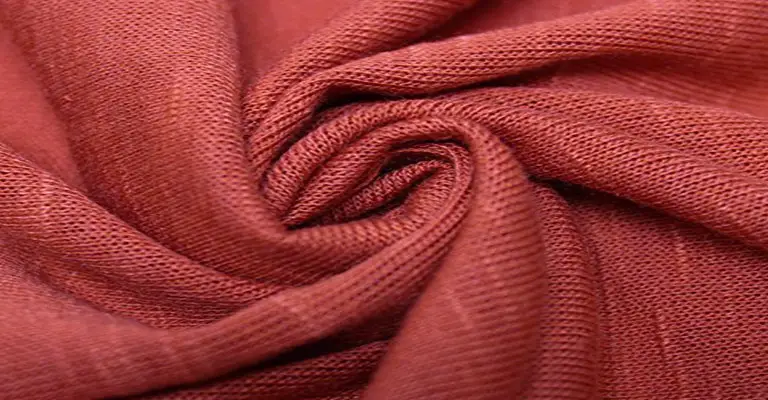Slub knit is a unique yarn-derived fabric having a somewhat unbalanced composition. That is to say, it consists of random chunky parts, almost like clogs of thread that are not twisted tightly like the rest. But oddly enough, it is these loosened portions that make slub knit softer than everyday fabrics.

Although slub knit used to be undesirable in the past, it found its way to becoming trendy, especially for casual attire. And so, it is worth taking a closer look at what slub knit is and whether you should hop on this trend or skip it altogether.
What is Slub Knit Fabric?
The heathered part of the slub knit fabric is thicker than the rest of its context, creating lumps called slubs. Interestingly, these slubs help create an irregular yet fascinating texture in clothes. Besides, the uneven part absorbs color differently from the other parts, giving the fabric an exceptional look.

Before industrializing yarn and fibers, people had to handspan the fibers into yarn or thread. After that, this yarn was hand-knit or weaved into the fabric for garment construction. Generally, hand spin yarn came with many defects or slubs, whereas the machine-made thread was nearly perfect. At that time, having slubs in the fabric was considered ugly and meant inferior quality.
But, most interestingly, more people began to view the slub fabric from a different perspective and added it to their outfits. Therefore, it started getting famous for its diversity despite having imperfections.
But when the machine spinning came, it produced perfectly even threads and yarn. Yet, the slub-yarn is in the hype for casual attire. So, the machine opened up an opportunity to make slubs with a deliberately predetermined spacing. The machinery can produce a more aesthetically pleasant pattern by maintaining definite gaps between the slub.
Hand spin cannot control the distance between two slubs, whereas a machine can. So, the machine plays a significant role in increasing slub-fabric production alongside aesthetic patterns.
However, the process required additional fibers and lint to be fed every few minutes. Yet, popular brands saw opportunities in it, the result of which is pretty apparent from today’s trends.
What Are the Features of Slub Knit Fabric
Like any other fabric, slub-knit has distinctive features of its own. These features make it different from others and build solid reasons for people to love it.
1. Material
Initially, slub knits were made with cotton only as it was the chief clothing fiber then. Besides, cotton is easier to wield both by hand and machine. That’s why cotton is still a significant material for slub knits. Yet, there are so many other materials that can make slub knits as well.
But nowadays, polyester has surpassed cotton because of its low cost of production. Unfortunately, it is tough to produce slubs with synthetic fibers as they require an entirely different spinning process. And the spinning process makes the synthetic slubs in thread very costly. So, despite being inexpensive, the spinning process increases the polyester slub’s final production cost.
Sometimes, cotton is blended with polyester or other synthetic fibers to reduce production costs. For example, it is almost impossible to find only cotton slub knits. Instead, you will find elastane cotton, acrylic cotton, or other cotton blends pretty easily.
In contrast, silk, and linen predominantly weave fabrics. But they are not appropriate for slub knit.
2. Heft and Texture
Depending on the types of yarn and thread, the weight and thickness vary from one slub knit to another. Besides, the texture is also dependent on the yarn material. You might get puzzled by its rather rugged look and feel. But in reality, it is pretty soft to the touch. For example, cotton slubs have a similar softness to cotton yarns. Do not let its chunky look fool you, as it is pretty soft.

Similarly, the higher the quality of the fibers, the better it feels on the skin. Besides, slub knits are light in weight and breathable.
3. Elasticity
All knit fabrics have an inherent stretching issue. So does the slub knit fabric. They usually stretch in all directions, mostly horizontally. Generally, whether the slub knit fabric stretches or not depends on the fiber content. When naturally stretchy materials get used, it adds to the stretchiness of the slub knit fabric.
Polyester and other synthetic fibers are known to be relatively rigid. Therefore, these synthetic fabrics add less stretchiness than other garments. Yet, when you use a poly-cotton blended contexture, it provides more stretchiness.
Likewise, slub knit made from materials like cotton-bend and elastane will be even more stretchy. On the contrary, if you don’t prefer such a large scale of flexibility, use double knit instead of single as two single yarn knits interlock tighter.
Frequently Asked Questions and Answers
Does slub knit fabric shrink?
Whether the slub knit fabric shrinks or not depends on the quality of the material. If the knitting element naturally shrinks, chances are the slub knit will also shrink over time. If the 100% cotton or wool has not been pre-shrunk, there is a higher possibility of shrinking with exposure to high heat. Yet, if the cotton slub knit is blended with polyester, it will not shrink.
Does the slub knit come from a mistake in the yarn?
Although slub knit was that undesirable defect resulting from spinning the thread once, it is no longer the case. These days, its production has become deliberate, with the popularity of such patterns. And in fact, it has its aesthetic appeal with separate colors on the different parts.
Final Words
Slub knit is presumably one of the most prominent examples of fashion trends following no predetermined patterns. What started as a fault in the spinning process took the trend chart by storm. Now, if you make up your mind to get your hands on this fabric, you’ll be glad to know it requires no extra care than your everyday fabrics.
Leave a Reply